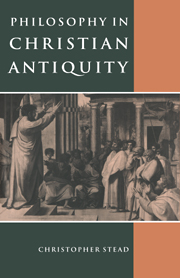Book contents
- Frontmatter
- Contents
- Preface
- List of abbreviations
- PART I THE PHILOSOPHICAL BACKGROUND
- PART II THE USE OF PHILOSOPHY IN CHRISTIAN THEOLOGY
- 8 The debate about Christian philosophy
- 9 Greek and Hebrew conceptions of God
- 10 Proofs of the existence of God
- 11 God as simple unchanging Being
- 12 How God is described
- 13 Logos and Spirit
- 14 Unity of substance
- 15 Substance and Persons
- 16 Christ as God and Man
- 17 Two natures united
- PART III AUGUSTINE
- Bibliography
- Index of Names
- Index of Subjects
16 - Christ as God and Man
Published online by Cambridge University Press: 29 September 2009
- Frontmatter
- Contents
- Preface
- List of abbreviations
- PART I THE PHILOSOPHICAL BACKGROUND
- PART II THE USE OF PHILOSOPHY IN CHRISTIAN THEOLOGY
- 8 The debate about Christian philosophy
- 9 Greek and Hebrew conceptions of God
- 10 Proofs of the existence of God
- 11 God as simple unchanging Being
- 12 How God is described
- 13 Logos and Spirit
- 14 Unity of substance
- 15 Substance and Persons
- 16 Christ as God and Man
- 17 Two natures united
- PART III AUGUSTINE
- Bibliography
- Index of Names
- Index of Subjects
Summary
Christology can be defined as ‘The study of the Person of Christ, and in particular of the union in Him of the divine and human natures’. This definition relies on philosophical concepts as employed in the debates about Christ which led up to the Council of Chalcedon in 451. The ‘christology’ of the New Testament is far less formal and unified; there is no mention of a union of natures, and the key-word prosōpon usually means ‘face’ or ‘appearance’, sometimes ‘dignity’ (Matt. 22:16 etc.) but never ‘person’, except perhaps at 2 Corinthians 2:10. Our present task is to explain how the philosophical concepts were introduced, what they meant, and whether their use is justified. For this purpose we need some account of the actual development of the doctrine of Christ; but this can be reduced to a mere outline, which can easily be filled in from the standard text-books.
The New Testament embodies two contrasted pictures of Christ. In the Synoptic Gospels he is unquestionably a man. He is set apart from other men by the authority with which he spoke, his miraculous powers, the prophecies which he fulfilled, his dispensation of the Spirit, his declared fellowship with the Father, his virginal conception, and above all by his rising from the dead. But he remains a Jewish teacher, a carpenter by trade, the son of Mary, along with his brothers and sisters. By contrast, the Fourth Gospel presents him as a heavenly being come down to earth, who can speak of ‘the glory which he had with his Father before the world existed’ (John 17:5).
- Type
- Chapter
- Information
- Philosophy in Christian Antiquity , pp. 187 - 201Publisher: Cambridge University PressPrint publication year: 1994

